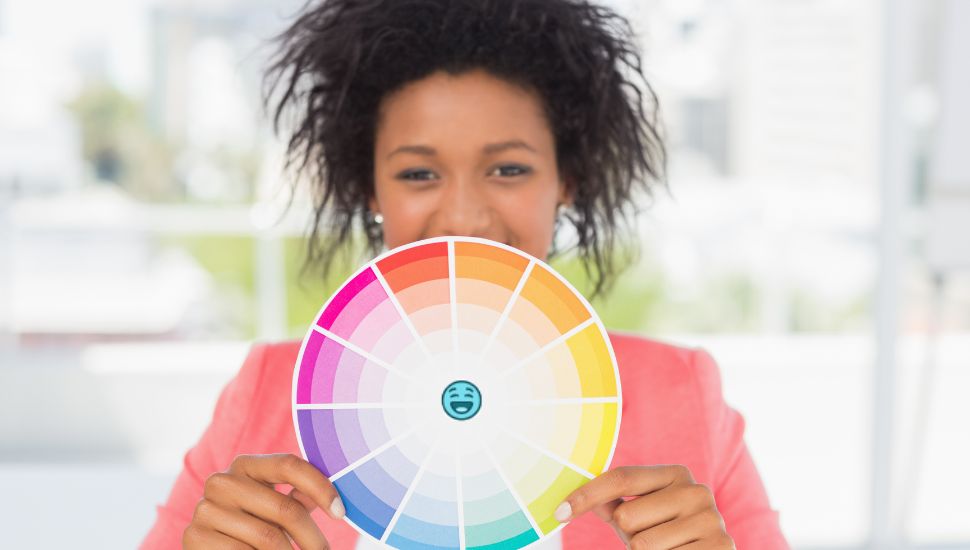Have you studied the psychology of color for your professional brand? Has LinkedIn studied the psychology of the color blue for its new laugh emoji?
There is a new laugh emoji on LinkedIn and then there is the psychology of color. You may have heard by now that LinkedIn released a new laugh emoji, and they made it blue.
Why blue? That makes absolutely no sense to me with the psychology of color. Why is the laugh emoji blue?
Just think about the psychology of color and the laugh emoji along with the existing emojis. LinkedIn already has a blue thumbs-up, green clapping hands, purple support hands, a red heart, a yellow light bulb, and a purple curious emoji.
It would have made more sense to make it orange to round out their emoji color palette. Besides, orange is a happy and cheerful color that makes sense when one laughs. I wonder what the reasoning was for making it blue.
What’s your favorite color, and should that be your brand? Whether self-employed, employed, or unemployed, you control the colors of your LinkedIn banner, photo, and what you wear.
If you are a business owner, you choose the colors of your logo and website. Why did you choose those colors? Are they appealing to all gender identities? Are they appealing to all ages?
When I was nine years old, my mom remarried, and we moved from Michigan to New Jersey and lived in an apartment for a year in South Bound Brook until we found a beautiful house in Watchung.
I got to pick the colors of my room and chose royal blue, turquoise, and lime green. Yes, those were the colors of my shag carpet!
As an only child, I lucked out with a two-bedroom suite and enjoyed a pool and artesian well in the backyard.
Not only was it the first time I got a kitten, but I also went on a Girl Scout trip to the humane society and fell in love with the most beautiful German Shepard. My dad rescued it the next day and surprised us by bringing Heidi to her new home.
Because that was a very happy time in my life, I have had those colors in my brand for decades.
As you know, change is constant. We evolve and sometimes we stay in the same industry, and other times we reinvent or pivot, which is perfectly acceptable.
In 1993 in California, I filed Around the Clock Executive Helper as an executive assistance business. I then refiled it in Chester County in 1994 when I moved back to Pennsylvania, and it became a virtual assistance business.
The services I offer have changed to writing resumes and LinkedIn profiles, but I am now working on developing a new brand with a new name and new colors.
I will not use my favorite colors, but colors that make more sense for the name I have chosen, which I will leave as a cliffhanger for now.
Just know that I will be taking a whole new approach to the new brand, inspired by the expression from Monty Python’s Flying Circus, “And Now for Something Completely Different.”
Believe it or not, I used to have weekly Monthy Python parties in my apartment in college in the good ole days!
Suppose you are thinking of rebranding, starting a new business, or want to make a color statement on your LinkedIn profile as an employed or unemployed individual. Where would you go to find the meaning of colors?
A favorite site to learn more about colors is Color Psychology. Whether conscious or unconscious, “color can evoke emotions, inspire reactions, and change modes of thinking.”
The Color Psychology website will provide you with the effects of the color, the positive and negative traits, what it means if you like or dislike the color, and more.
The website shares some aspects of the color wheel and color theory and defines what complementary, split-complementary, triadic, tetradic, monochromatic, and analogous colors mean.
Choosing a set of colors for your brand can be a manual selection process, or you can choose pre-selected color palettes for your graphics if you use Canva.
If some of the colors you are considering are metals like gold, silver, and copper, read more about what they mean on the Ancient Symbols website.
So, if you are curious about what the color psychology is that represents your existing brand or what colors should represent your brand as you develop it, do some research and check out the links I shared!
Maybe it can be part of a story of the birth of your brand! I know I will have one!
NEXT STEPS
- Subscribe to my newsletter on LinkedIn for bright ideas to manage your career.
- Join as a member at https://httpsgreatcare.wpenginepowered.com/membership of the #1 business networking association on the Philadelphia Business Journal’s Book of Lists two years in a row!
- Register on the events page for these upcoming online events noted below.
- If you need a resume or LinkedIn profile to get you to your next step, book a call to chat!
- Follow #GreatCareersPHL
AUTHOR BIO
Lynne M. Williams is the Executive Director of the Great Careers Network, a volunteer-run 501(c)3 nonprofit organization that provides career education and networking connections for 1) job seekers in career transition, including veterans, and 2) employed and self-employed for career management. She is also the President of ChemPharma.net and runs a Clubhouse session every Friday at 11 AM ET in the Thought Leadership Branding Club.
Aside from writing keyword-focused content for ATS resumes and LinkedIn profiles, Lynne is currently writing her doctoral dissertation on LinkedIn for Job Seekers. She is a contributing author on “Applying to Positions” in Find Your Fit: A Practical Guide to Landing the Job You Love along with the late Dick Bolles, the author of What Color is Your Parachute?, and is also a speaker on career topics.
This article is also published on: vista.today, montco.today, delco.today, bucksco.today, and in the author’s LinkedIn newsletter. A list of articles can also be found in a Google doc.




